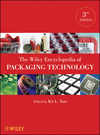Technology: Inks
Electron Beam-Curable CI Flexo Ink Technology




Over the past decade, some of the most prestigious ink companies have been hard at work developing EB-cured alternatives to today’s conventional solvent-based CI-flexo inks. Sun Chemical first introduced WetFlex several years ago as an EB curable alternative. A water-based, EB platform which improves the physical properties and adhesion challenges faced by conventional water-based inks is scheduled for release later in 2014 as well.
And now, another new EB-curable flexo ink technology platform has arrived: Gelflex-EB from Techno Solutions. It promises to offer the marketplace both an economic and an environmentally sustainable alternative to current solvent systems.
Better Quality
Flexible packaging printers have always been striving to improve quality and consistency. To this end, wet trapping of 100 percent solids EB-curable inks have been in use for decades on web offset presses to produce best-in-class graphics. And with the recent advancements and cost reductions in web offset press technology, this process, and these EB inks, continue to gain share in flexible packaging.
These same physical properties and characteristics available in offset are now available on CI Flexo presses with GelFlex-EB: 180 LPI (70 LCM) for higher resolution and tonal value; 50 percent less dot gain for higher contrast, brightness and smooth vignettes; Smooth ink laydown, reduction in graininess, and higher Solid Ink Density (S.I.D.); and the broadest range of physical properties, including gloss; abrasion and scuff resistance; and chemical resistance.
Reduced Cost
But customers don’t want to pay more; in fact, they strive for planned year-over-year cost reductions. To most printers, this is the biggest reason GelFlex-EB inks will make so much sense: cost reduction.
A GelFlex-EB installation will use up to 80 percent less energy with a typical EB using only 30-40kW of electricity. Additionally, it will use 60 percent less color ink laydown and 65 percent less last-down white ink.
And since the last-down white is made up of 100 percent solids, this further reduces both the amount of ink bought and the amount of solvents emitted. Material waste is reduced due to no thermal substrate distortion, since the temperature rise in an EB process is usually no greater than 20°F.
Printing is all about dots and dot control. GelFlex-EB ink is a high-solids ink (like most EB inks) and that helps achieve a smaller and more consistent print dot. This allows the use of an expanded gamut inks system, further reducing both the number of colors used and the number of ink color changes.
The result is higher uptime, more consistency and productivity. And consistent with energy cured inks, the EB inks can be left on press between runs, shifts, and even weekends, decreasing the clean-up time and again increasing uptime and productivity.Furthermore, with about 90 percent reduction in solvent emissions, the use of abatement equipment is significantly reduced further reducing utility, compliance and insurance costs.
GelFlex-EB ink consumption will be about 2.5 to 2.8 times less than conventional inks. That is due to the high solids content and ink formulation permitting higher pigment loading. This leads to an overall reduction in ink cost on a per msi basis. When combining all these factors the cost to print, using Gelflex-EB inks is actually lower than the cost to print with conventional solvent or water based inks.
How it Works
The Gelflex-EB ink technology accomplishes wet trapping on the principles of organogel formation using Hansen’s solubility parameters (HSP). With Gelflex-EB, a small percentage of solvent (between 0 percent and 15 percent) is added to adjust the solubility parameters of the ink. As the solvent evaporates from the first color, the ink immediately undergoes a phase change and becomes a hard gel allowing the second color to lie on top of it and so on.
Gelflex-EB inks uses energy-curable resins and the use of EB curing enables adhesion to difficult substrates and compliance with global food laws. For curing of ink, low voltage Electron Beam equipment like the FlexoBeam from Energy Sciences Inc. (ESI) is needed for curing the ink at the end of the printing process. Interstation hot air drying is not necessary; however, a small overhead end-of-press dryer is recommended for some applications to remove residual solvents before final EB Cure.
Uteco has led the way in press development for this type of CI-Flexo ink. Requirements from CI-Flexo printing press are closed doctor chambers; Pumping system must be capable to work in a recommended viscosity range of 300-500 cP; Thermoregulation system to control the temperature of the inks in the range of 30-35°C is highly desirable. One way to maintain this desired temperature is the patented Thermilox systems from Uteco.
A dynamic use of GelFlex-EB occurs when looking to print and coat in-line; or print and adhesive laminate in-line; or print and crosslink in-line. The formulation of the GelFlex-EB inks allow for all of these in-line processing options with just one (1) EB machine located at the end-of-press. The GelFlex-EB inks can be applied on various substrates including various papers, films, heat shrinkable film tubes, and foils.
Printers today are under constant pressure to maintain graphics quality while delivering year-over-year cost reductions. GelFlex-EB ink can give you both: Cost reduction through ink savings, waste savings and productivity gains, combined with better image quality and smaller dots. And all while decreasing emissions 90 percent with an ink technology that is safe for food and sustainable.
Energy Sciences Inc.
sales@ebeam.com; www.ebeam.com
Looking for a reprint of this article?
From high-res PDFs to custom plaques, order your copy today!










